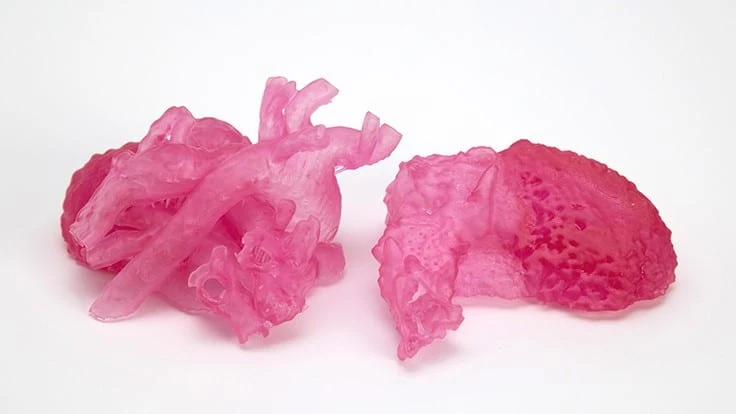
Henkel/NewPro3D
Three quick medical device reads today…Coronavirus is taking the lead spot in news around the world. As the outbreak numbers increase, medical technology we’ve covered in Today’s Medical Developments magazine is helping monitor patients without exposing caregivers to the virus.
Next, it may be 2 weeks before Valentine’s Day but collaboration between Henkel and NewPro3D gives us the lead photo – a soft tissue anatomical model of a heart – and information about the two companies collaborating to provide additive manufacturing (AM) solutions at production scale for the medical industry.
Finally, VADovations’ cardiac assist pump for long-term use in patients suffering with heart failure is getting a boast as the company licenses IP from Mayo Clinic, advancing this next-generation technology designed to avoid open surgical implantation while addressing the limitations of current blood pumps.
VivaLNK's continuous temperature sensor monitors Coronavirus in China
VivaLNK officials announce that the Shanghai Public Health Clinical Center (SPHCC) is using VivaLNK's continuous temperature sensor to combat the spread of Coronavirus in China.
A key challenge in combating contagious diseases is limiting the spread of the virus within a hospital. Cross infection from patient-to-patient and patient-to-caregiver can be a major problem. While quarantining patients may limit patient-to-patient contact, contact between caregivers and patients can also be avoided with technology.

Working with VivaLNK solution partner, Yijing Health, the temperature sensor is applied directly onto the patient and allows for continuous, real time monitoring of changes in body temperature. The data is then sent electronically from the patient to a remote observation dashboard at the nursing station, providing a view of the patients. Now, instead of physically checking the patient temperature every few hours with a mercury thermometer, temperatures can be monitored remotely and automatically, thereby limiting patient-to-caregiver contact. SPHCC also plans to deploy other VivaLNK sensors to monitor vitals such as heart rate and respiratory rate. In addition to SPHCC, the VivaLNK solution has been deployed in four other hospitals in various locations throughout China.
The VivalNK temperature sensor has clearances from the CFDA, FDA, and CE, and is part of VivaLNK's medical wearable platform which includes sensors to monitor a variety of other vitals and biometrics.
Shanghai Public Health Clinical Center uses VivaLNK continuous temperature sensor to monitor patients, combat the spread of Coronavirus.
Henkel, NewPro3D collaborate for 3D printing solution
NewPro3D recently joined Henkel’s Open Materials Platform to provide additive manufacturing (AM) solutions at production scale for the medical industry. Henkel’s materials expertise and NewPro3D’s 3D printing equipment and software is enabling new applications in anatomical modeling, prosthetics, and more.
NewPro3D’s unique technology for digital light processing (DLP) produces 3D models at record speeds. Specifically, the company’s Intelligent Liquid Interface (ILITM) consists of a transparent wettable membrane that is chemically designed to facilitate faster movement between cured layers, eliminating the slow mechanical processes used on conventional 3D printing techniques. When used in combination with Henkel’s wide range of photo-curing resins, the result is ultra-fast manufacturing of medical devices and tools including hard and soft anatomical models for use in surgical planning and educational programs.
NewPro3D and Henkel will be showcasing applications at the MD&M West, Feb. 11-13, 2020 at the Anaheim Convention Center in Anaheim, California, booth #2321.

One will be an anatomical model of an infant’s skull. In this particular case, the child was afflicted with a syndrome that caused misalignment of the anterior mandible. To correct the issue, doctors must lengthen the mandible to approximate the maxilla. The model serves an invaluable role, helping the surgical team more accurately measure the defective position and identify areas where a device can be anchored to lengthen the mandible, in addition to helping them more easily visualize the overall position of other cranial bones.
Doctors were able to develop a treatment plan that involved the construction of an osteodistraction device that was placed in the body of the mandible. As dictated by the treatment plan, the apparatus featured external screws, which were rotated daily to a prescribed number of revolutions.
VADovations licenses IP from Mayo Clinic to develop a novel next-generation endovascular cardiac assist device for long-term use
VADovations Inc., a company developing miniaturized cardiac assist pumps is licensing intellectual property (IP) from Mayo Clinic for endovascular deployment of VADovations’ novel cardiac assist pump for long-term use in patients suffering with heart failure. This next generation technology is designed to avoid open surgical implantation while addressing the limitations of current blood pumps.
Kurt Dasse, Ph.D., president of VADovations, says, “Advancing our mission to deliver the best, most widely adopted implantable cardiac assist technologies that overcome the limitations of current and emerging devices, we are proud to draw on the clinical expertise of Mayo Clinic enabling our newest innovation: the endovascular deployment of VADovations’ ultra-miniature cardiac assist pump uniquely designed for enhanced safety and cost-effectiveness. Percutaneous insertion and catheter-directed navigation through blood vessels to the heart avoid the need for extensive open-heart surgery, as is required for other cardiac assist pumps today.”
Latest from Today's Medical Developments
- Arcline to sell Medical Manufacturing Technologies to Perimeter Solutions
- Decline in German machine tool orders bottoming out
- Analysis, trends, and forecasts for the future of additive manufacturing
- BlueForge Alliance Webinar Series Part III: Integrate Nationally, Catalyze Locally
- Robot orders accelerate in Q3
- Pro Shrink TubeChiller makes shrink-fit tool holding safer, easier
- Revolutionizing biocompatibility: The role of amnion in next-generation medical devices
- #56 Lunch + Learn Podcast with Techman Robot + AMET Inc.





